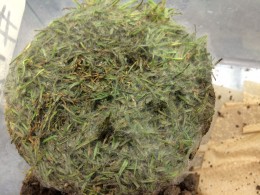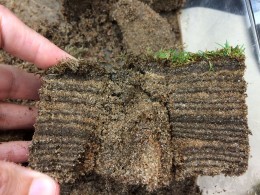(Megan Kennelly, KSU Plant Pathology)
The soggy weather continues, and diseases are in full swing. Dewy, wet mornings lead to mycelial growth of the pathogens that cause dollar spot or foliar Pythium. These are mainly golf course concerns, but the diseases can occur at other sites.
Here is a sample that came into the lab, loaded with foliar Pythium:
It is from a golf course fairway at a site that has received a lot of rain and some foggy mornings where everything is wet-wet-wet.
For management info on foliar Pythium, you can check these links:
http://www2.ca.uky.edu/agcomm/pubs/ppa/ppa1/ppa1.pdf
(scroll through to the Pythium part on p.17)
http://extension.missouri.edu/p/IPM1029-17#Pythiumfoliarblight
Root health continues to be a problem, especially on putting greens. We’ve posted a lot of information this year about wet soils leading to physiological decline and triggering Pythium root rot in some cases (see links at bottom of this post). Putting greens with poor drainage, less-than-ideal construction, or a build-up of organic matter are particularly susceptible. Here are some putting green rootzones with a lot of organic matter build-up, visible as dark layers:
All those layers kind of look like tiramisu…mmm… yummy… getting distracted.
Unlike delicate layers of a tiramisu, layering in a putting green rootzone is NOT a delectable delight. Another complication of poor drainage is that it can make the turf more prone to anthracnose. I received a couple of samples in recent days with crown rot anthracnose. Both also had layering problems and root decline.
There is some information about anthracnose here:
http://www.bookstore.ksre.ksu.edu/pubs/EP147.pdf
and here is an excellent list of best management practices:
http://turf.rutgers.edu/research/bmpsanthracnose2015.pdf
Many of the practices to reduce anthracnose also promote overall turf health. That is, when you implement agronomic practices to promote good rooting you also reduce the risk of anthracnose and other problems. You may not be able to do ALL of the beneficial agronomic practices you would like, due to budgetary limits or lack of equipment or golfers’/greens committee opinions, but the more you can fit in, the better.
We posted on these topics earlier this year. If you want to go back and review, here are some links:
https://blogs.k-state.edu/turf/root-decline-it-aint-benign/
https://blogs.k-state.edu/turf/best-management-practices-for-turfgrass-anthracnose/
https://blogs.k-state.edu/turf/your-turf-is-trying-to-bike-up-a-mountain/




